
How to use the image search engine
This article explains how to identify your coins, even if you have no knowledge of numismatics.
Summary:
- Quick description.
- How to recognize images on your coins.
- Codification of legends.
- Example of identification from A to Z.
Quick description
Identify your coins with more than 2600 pictures of emperor portraits and various characters or elements on the reverse. I add dozens of photos every day and, at the end, every portrait of emperor will be bound to all the reverse struck under his reign and each setback will send back to all the emperors who struck those reverse. This article was made on 03/05/2018, the number of photos is 2600 so far, understand that if you read this a few months after the writing of this article, the number of photos added will have increased significantly. Actually, each type contains less example in a metal struck with an example of associated emperor. If you find a coin, first look at the example in gray, the metal categories with coded legends (exactly, the position and the space between each word, described here in the article), are currently very much supplied but not yet complete. Example: you find your reverse ASIA and the only example is on silver, it does not mean that this coin is not supposed to exist in bronze! In the meantime, in the coming monthes, that your engine is 100% complete, take your identified type and search on GOOGLE if you can not find your currency here. Just write (for example) FEL TEMP REPARATIO, CONSTANS.
The photos of portraits of Roman emperors are about 1100. Classed by emperor, mint, style, crowns, helmets ... For the reverse, there are 900 different types of reverse and 1500 reverse photos with their variants, different legends, by existing metal etc ...
How to recognize images on your coins
- Take your coin and look at the metal, then try to identify the portrait on the obverse by browsing the pictures of emperor portraits in the corresponding metal. This method eliminates immediately emperors who have never struck in the metal of your coin. This refines your search.
- Look now at the other side and flip your coin over to see if you distinguish a shape if your coin is very worn. What do you see? A rectangle for example? So look in the category "camp doors" or "monuments". If you see a single character standing up, these can be categories: "standing emperor", "standing divinity", "standing allegory". Look at all categories mentioning a single character standing up.You will find a dark gray image denoting the general type , click on it to open the subcategories and find an accurate picture in the metal struck.
WARNING: If you can not find your coin, this can be due to several reasons:
1) Because antique coins are hand-engraved, you can have an original portrait that differs from most others and is unrecognizable from the usual portraits. So think about whether your emperor has a beard or not, curly hair, lean or round face etc ... to eliminate maximum results. Then if you still block, go directly to the reverse. Indeed, finding the reverse is very simple and my classification allows to know which are the few emperors who hit type of setbacks.
2) The metal: a thing to note: from 300 AD, the coins are with a low rate of silver, therefore we say "billon". I have classified the billon in the "bronze" category, but your coin may be with a high rate of silver. Therefore, remember to check in the other metal.
3) Wear: If your coin is worn out, an item may be erased. Example you see a single character standing but can not find it? This character can have a child at his feet and therefore be the allegory VENUS, child disappeared with usury.
4) Your coin is not actually known. It is very scarce but there is probability that you discovered a new type or a type known but not known on a specific metal or associated with an specific emperor, for example.
5) It's a Gaulish imitation, so your coin does not look like the official coin. Look at the diameter and weight to determine if your coin is official or not. Weight or small diameter = barbaric imitation. Here, only official coins are listed on the image search engine.
Codification of legends
How to read coded legends:
A "legend" is the numismatic term for words written on a coin. Very often inscribed in a circle on the edges of the coin.
- Dash 6 ( - ) denotes a space in the same word. Example: VETRANIO which is written VETRA - NIO.
- Large dash or alt + 0150 ( – ) denotes a space between two different words. Example: IMP and VETRANIO will become IMP – VETRANIO.
- Slash ( / ) means a word in the field of money. The numismatic field designates the central part. A word that is written vertically, not along the currency but in the center. Example: / S - C.
- Dash 8 or underscore ( _ ) means a word in the bottom of the coin, below the drawing, usually below the line of the ground. Example _ VENUS. Attention: the marks of mints are not noted. How to differentiate a mint mark and a legend? A legend is a word or a beginning of a word. A mintmark consists of letters and symbols: ![]() SIS for example.
SIS for example.
- ( ) word in parentheses means that it is written in an element of the drawing, for example: in a shield.
- (VIC _ AVG) means that the words VIC and AVG are written in two lines and that AVG is below VIC, both written in an element of the drawing.
To finish: Mint symbols such as letters in the field or stars are not contained in the images because they are marks and not an element of the drawing defining the type. Pay attention to each small element, two images may seem similar to you and however the orientation of the head is not the same (for example).
Example of identification from A to Z
Imagine that you have this coin and want to identify it. What do you see?
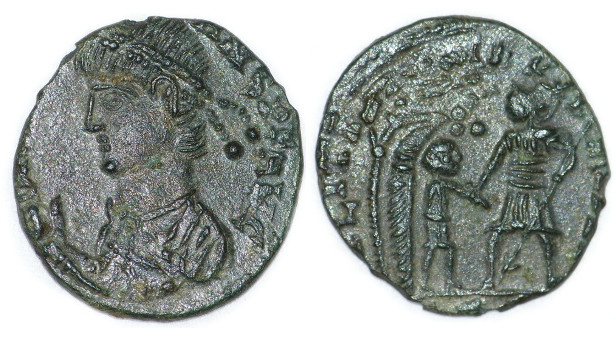
Precision on this photo, the style indicates that it is probably a Gaulish imitation of very good quality. However, I chose this coin because it illustrates my point perfectly.
First, analyze the reverse, indeed if you go directly on the obverse you may find some portraits of emperor similar to the portrait above, but you can not identify one precisely because as I already say: considering the mint, the engraver etc .. a portrait may be different from those usually encountered (see below).
Let's look at the reverse, we see that two characters are visible. Categories showing a single character are eliminated. Another detail: the character on the right has a helmet, so it's a soldier. He drags a smaller character, so its a captive. It is therefore in the category "soldier with captive" that we must look.
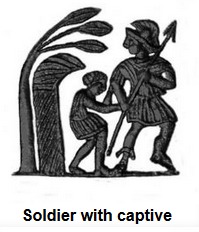
We observe that the miniature of the category is already the reverse of the coin. You click on this thumbnail and discover two other similar miniatures with a legend "FEL TEMP REPARATIO". In many categories you will have various choices of legends. Here in this category "soldier with captive" and with this picture, only the legend "FEL TEMP REPARATIO" exists. So you click on it and one of the other gray sub categories appear.
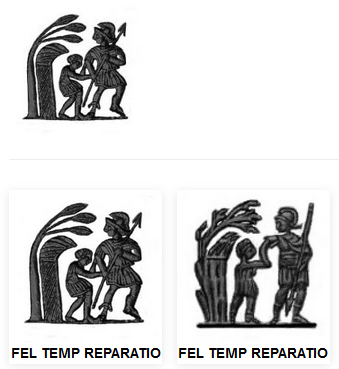
Above is a picture of the main type and below the two known variants.
WARNING! Here, only the position of the spear must be the criterion of choice. Indeed, you notice a difference of style between the two pictures, it is the style of the mint. I am currently, the day I write this article, on 03/05/2018, in full work on the styles of mints, which will be gradually added (more details below on the classification of these styles).
So you know that your coin has a soldier with the spear between his legs and not between him and the captive. You click on the second picture. You open another category, this time classified by metal: first GOLD, then SILVER and finally BRONZE, via a color system. I repeat it here, if your coin is on silver you can look also in the category bronze: indeed, the problem of "billon" is that those coins own a low rate of silverand are predominantly of bronze color. But, it is possible that your coin own a higher rate of silver and therefore be whiter (silver color) than bronze. The billons are classified by logic in the category of bronzes.
For even more precision, you will have for each type, one or more representations for the same metal, because they each show one or more legends with the known breaks. A break can be unique to an emperor or to a mint or a denomination (a denomination is the name given to a module, here the coin in photo that we are talking about is a follis). This greatly refines your search. Example, i discovered that the legend break VETRA - NIO is unique to the mint of Siscia and VETRAN - IO is unique to the mint of Thessalonica. More details here: https://www.all-your-coins.com/en/emperors/romaines/vetranion.
You open this picture:
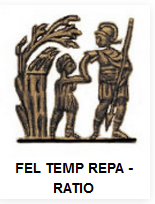
As I already explained, you see a legend with his break. You can ignore legend breaks because they are numerous and many new ones are listed every day. If your coin has exactly the same legend break, all the better, this refines your search once again. If you do not find the same break, no problem, browse the others, you will find your coin. The details of legend breaks are very specific details of which very few people, including auction houses, do not hold back. The important thing is that your coin is a FEL TEMP REPARATIO. Even if the breaks can show precisely a mint for example.
Now that you have found your exact miniature, in the right metal, you click on it and notice that two emperors are proposed: Constans and Constantius II. Considering that the two legends for each of them are close:
- D N CONSTA - NS P F AVG
- D N CONSTAN TIVS P F AVG
and that the two portraits are pretty similar, how do you know who is the emperor on this coin? In the very difficult cases explained below, we can only refer to style, marks, breaks of legends, to identify an emperor or a mint, if the legend has completely disappeared. In any case, you are probably here to know the value of your coin and in this case one thing: you will have, due to this search engine, your identified type, the associated legend and at the maximum, two or three emperors having struck this type. If your coin is so worn that the legend is unreadable, look on GOOGLE, example our FEL TEMP REPARATIO, if you find more than 15 results for the same mint, you know that this coin is not rare and therefore, considering the state, this does not not cost more than 20 € (this is an example of price and not the real cotation of this coin).
Here, on this coin, no doubt, it is a coin of Constans, why? Because, on the obverse, at 2 am, we clearly see ANS then P F AVG, and not TIVS P F AVG.
That's it, you've easily identified your coin.
For the representations of style: they will be added each day and will be present in the last subcategory, example, for the coin above, the illustrations of style will appear in the category bronze with the associated legend. I repeat, while waiting for this work, it does not affect the identification of your coin, these are complements.
To summarize in stages: find the emperor and then the associated titles and the type of reverse. Finally, refer in this article to the list of mints marks to determine your mint. Then look for your coin, either in the ancient coins database of this same site to find a cotation or either on google if I have not added and evaluated this coin yet.
ATTENTION THE CASES DEVELOPED BELOW ARE EXTREME CASES !!!! YOU WILL MEET THIS KIND OF CASES VERY RARELY!
HOWEVER, IN A CONCERN OF CLARITY AND FOR YOUR INFORMATION, I WANT TO TALK ABOUT IT.
In many cases, you will find your emperor directly because his head is really different from the others, example: Trajan, but from the 3rd and 4th century, differentiate the emperors is a little more difficult. The picture board of the search engine by image is very useful to immediately eliminate a hundred emperors and to extricate a few.
An example:
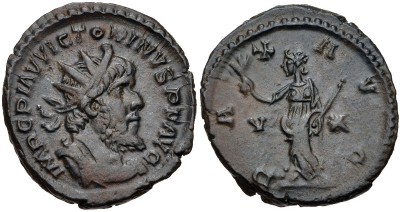
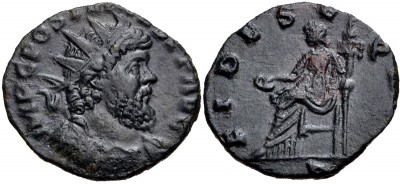
Without looking at the legend, imagining she is unreadable. Who is Postumus and who is Victorinus?
The first coin is for Victorinus, the second is for Postumus. When we know each other, we see the difference, but if you are not a connoisseur, how can you know? At the stage where you are in your search, you have only two emperors possible. Looking at the reverses you can also eliminate one of the two emperors because he did not struck this reverse (in any case, no one knows of this type of reverses struck for this emperor to this day). It is 99% likely that it is this emperor and not another on your coin. Now, how to be 100% sure whether it's an emperor known to have stuck that reverse,or that it is a new reverse struck and therefore a discovery?
Due to my system, you will be able to see what are the associated legends for each emperor and reverses, all intelligently ranked by emperor, type, workshop, style, legends, and even legend breaks.
Now let's push the difficulty to the extreme: you must have noticed that the character on the reverse of the first picture has, on his left: V and ![]() on his right. In this case, if your coin contains these two marks, it is Victorinus and not Postumus or we made a discovery. How to eliminate the probability of discovery?
on his right. In this case, if your coin contains these two marks, it is Victorinus and not Postumus or we made a discovery. How to eliminate the probability of discovery?
You probably still have some letters around the portrait, if you see C P one after the other, no doubt it's Postumus. Why are these two letters important? Simply because when you have looked at the legends for Postumus you have seen: IMP C POSTVMVS F AVG (for example), these two letters C and P one after the other, do not exist for Victorinus. But again, if the obverse can tell us an emperor, the reverse can also: an emperor will have struck PAX AVG and another PAX AVGG. But you'll tell me: how to rule out a guy's discovery with AVGG struck for an emperor known only for striking the reverse with AVG? In the case of legends, it's very simple: they indicate the name and titles obtained by the emperor. So you can not give him titles that he did not get. However in rare cases, we can find an existing title for an emperor but whose mention on a specific type of reverse was not yet known. Example COS III unknown so far for one type, but known on others.
To complete, the reverses are all related to current events or those that have just happened, VICTORIA GERM, for a victory against the Germans, etc. The Roman coins served as a newspaper for the Romans who were far from event. That is why it is very unlikely that you have made a discovery of a type association to an unknown emperor. And anyway as I explained to you, with legendary tips, mint marks, portrait style, crowns, bust orientation, etc. you will find your coin without any problem. And all of it is on this picture search engine.
But, sometime (very rarely) the problem of "hybrid" can appear. Hybrid mean that a reverse or obverse die of an ancient emperor were used later for the new emperor. In those case, the die used is probably a few worn so your coin is probably showing a side of poor striking quality (soft impression, details broken or missing). And the most important: we classify a coin as hybrid because the obverse/reverse association is not correct: like titles on the reverse legend never obtained by the new emperor or a type who is not correct too. Example: as i said VICTORIA GERM for an emperor who never known conflict or any historical moment with the germans.
If you have doubts about a coin, you can send it here: https://www.all-your-coins.com/en/contact. The photos you send me will not be published other than as a drawing. See the following example to see how i add the coins:
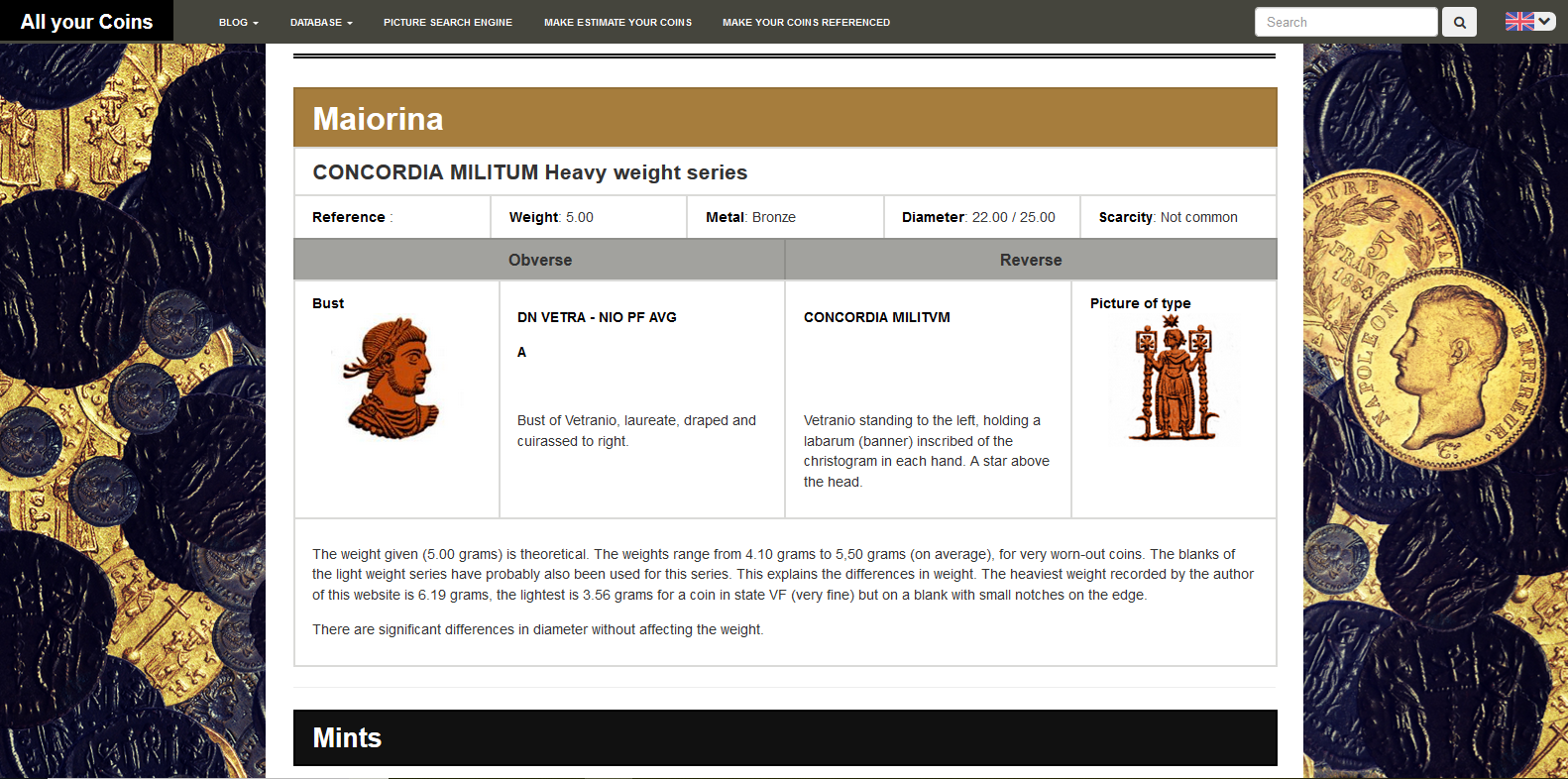
So we can not recognize your money precisely (no patina, legend position or other element) Therefore I simply list the coin without tracing their existence, sale etc ... and it will be impossible for any visitor to determine that the drawing displayed on this site is an illustration of your coin the day you sell it for example. I just want to reference their existence. You have the freedom to anonymously deposit your coins without tracking.
While waiting for all the reverse and obverse to be linked together, you will find (work in progress) on each emperor portrait for each metal, a detailed list of known obverse legends. This will be enough for your research.
To finish: mints symbols such as letters in the field or stars are not contained in the pictures because they are marks and not an element of the drawing defining the type. Pay attention to each small element, two pictures may seem similar to you and yet the orientation of the head is not the same (for example).